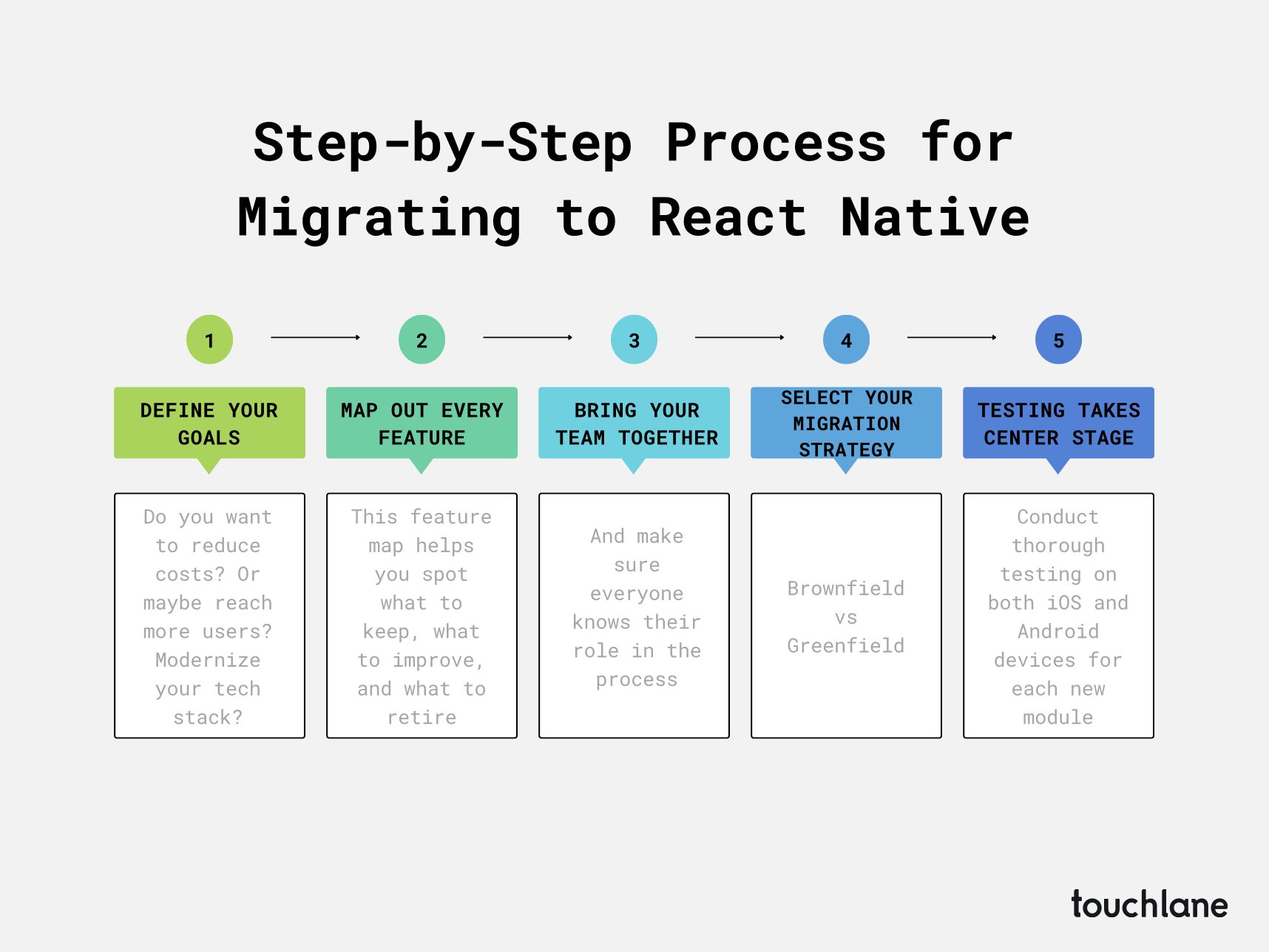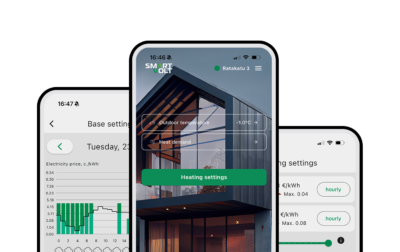Why and how to migrate your native app to React Native – A practical guide
Intro
Speed, agility, and resource efficiency are essential in today’s mobile environment. Maintaining distinct native apps for iOS and Android strains teams, depletes funds, and impedes innovation for many companies. React Native, a cross-platform framework supported by Meta, has become a viable substitute that helps businesses satisfy increasing user demands without having to do more work. It offers a smarter, unified path forward.
In this article, we at Touchlane will explain when it makes sense to migrate a native app to React Native, what to anticipate as obstacles, how the process usually goes, and why it might be the best course of action for your company. You can find time-, money-, and resource-saving insights here if you are preparing the next phase of your mobile strategy.
React Native in numbers
- React Native has 122k stars on Github as of April 2025 – this shows that many developers trust and actively use the framework in their projects
- According to data from the 2024 Developers Survey by Stack Overflow, 8.4% of programmers use React Native
- More than 155k people are members of the React Native community on Reddit
- As of October 2024, 790 apps that used the React Native framework software development kit (SDK) brought in between $10,000 and $100,000 per month.
When it makes sense to migrate from native to React Native
- Faster time-to-market
If entering the market swiftly and delivering updates quickly is your priority, React Native is worth considering. As per a preliminary global benchmarking survey conducted by research2guidance, more than 50% of cross-platform tool users say they save more than 30% in development time. React Native satisfies this need as it offers a shared codebase across platforms, which helps businesses respond rapidly and win over customers.
- Cost efficiency
It usually takes two entire development teams to create and maintain two distinct native apps. Thanks to React Native, one team can be used for both platforms, which reduces costs for updates and support as well as salaries – as long as the app does not rely heavily on platform-specific features.
Unsure if native or cross-platform suits your project best? Check out our detailed comparison of both approaches.
- Flexibility
Lastly, when time is more important than platform-specific polish, React Native allows teams to simultaneously release updates across platforms. Those that need to move quickly in competitive markets will benefit greatly from new features like Expo Router, which was introduced in 2024 and allows developers to manage app navigation without diving into native code.
To put it briefly, switching to React Native makes it easier to stay ahead of the competition without overspending with faster development, reduced expenses, and increased flexibility. Though for some advanced features, native development is still necessary.

Evaluating the feasibility of migration to React Native
If you have decided to migrate your native app to React Native, begin by assessing three major factors that necessitate such migration – project requirements, budget, and resources.
Project requirements
Start by outlining the main features of your existing application. Which characteristics need to remain unchanged? Which of these could be altered without damaging the user experience? A complete migration might require additional development time to match native performance if your app significantly relies on device-specific features, such as sophisticated animations, background processing, or custom camera functions.
Budget
The budget comes next. As mentioned above, React Native is a cost-effective solution. However, the initial migration is not always cheap. What determines the cost is how much of the current code can be reused and how much must be rewritten. Before the migration process even starts, apps developed years ago – especially those using antiquated frameworks – often need extensive refactoring.
Resources
The decision is also influenced by internal company resources. A strong internal team with expertise in React and JavaScript speeds up and improves the reliability of migration. If your team lacks this knowledge, you will need to invest in training or arrange for outside assistance, both of which can put a strain on finances and schedules.
What do these factors mean for your business? Migration can easily fit into your roadmap if your app needs a significant redesign or functional overhaul anyhow. If the application is stable and in the middle of its life, the disruption from the migration might currently outweigh the advantages.
Taking time to measure all these factors gives companies a sharper view of what migration would mean — not just in theory, but in real numbers and business impact.

A step-by-step process for migrating your native app to React Native
Here is how businesses transition from native mobile apps to React Native with a clear route, from planning to complete deployment.
1.
Planning
Start with a clear vision. Define your goals for the migration. Do you want to reduce costs? Or maybe reach more users? Modernize your tech stack?
Next, map out every feature in your current app. This feature map acts as your blueprint to help you spot what to keep, what to improve, and what to retire. Solid documentation is your best ally here. Make sure every screen, workflow, and integration is well-described and easy to find. This step helps your team move with confidence and avoid surprises later.
Bring your team together and make sure everyone knows their role in the process. The migration proceeds more smoothly and morale remains high when everyone is aware of the goal and anticipated results.
2.
Development
Select between brownfield and greenfield migration strategies. Brownfield allows you to migrate features one at a time and run new React Native screens alongside native ones. At the same time, greenfield means creating the app from scratch in React Native. Overall, brownfield offers a safer transition for many businesses so you can test React Native in production without jeopardizing the entire application.
Next, configure your React Native environment and recreate the user interface of your application. Make sure everything functions as planned by carefully transferring business logic and APIs. Work in discrete, small modules; begin with one feature and thoroughly test it before going on to the next. This strategy minimizes risk and makes progress evident.
3.
Implementation
The focus is on testing. Conduct thorough testing on both iOS and Android devices for each new module. Resolve problems as they arise and maintain team communication. Merge a module into the main application after it has passed all checks, then repeat the procedure for the following feature.
Once every feature has been transferred, concentrate on deployment. Release the updated app to users, keep an eye on performance, and promptly respond to any comments. Maintain your app regularly to keep it in optimal condition and prepared for updates in the future.
Lastly, train your team on the new setup and document the entire migration process. Later on, when you need to scale, hire more developers, or introduce new features, this investment will pay off.

Challenges in migrating a native app to React Native
Although it is not always easy, moving from a fully native mobile app to React Native can lead to new opportunities. Yet, there are challenges along the way, even though the long-term benefits can be significant. Knowing where things can go wrong helps in setting realistic deadlines and expectations.
Challenge one. Careful rebuilding with various foundations
Native apps use platform-specific code, such as Swift or Objective-C for iOS and Kotlin or Java for Android. React Native utilizes a shared codebase and speaks a different language, JavaScript. This implies that current native components will not be directly transferred. It might be necessary to completely rewrite some features, particularly if the application relies on intricate platform API integrations.
Challenge two. The design does not always translate cleanly
What looks great on an iPhone might not work as well on an Android device, and vice versa. Although React Native promises cross-platform consistency, platform-specific design patterns still exist. Instead of depending on the outdated native templates, migrating the app entails reviewing UI choices with consideration for both platforms.
Challenge three. Performance is more than just speed
An app built with React Native often feels fast – but not always. React Native may not be able to match the original native app’s performance right out of the box if it was designed for performance-intensive tasks like complex animations or video processing. As a solution, the cross-platform framework and custom native modules are frequently combined, which complicates development and maintenance in the future.
Challenge four. Third-party libraries are not always ready
Typically, native apps rely on multiple libraries. These same libraries might not have equivalents when switching to React Native, or the ones that do exist might not be mature enough. Development may be slowed down and require unforeseen workarounds or unique solutions.
Challenge five. Testing needs a fresh approach
React Native testing techniques are different from those used in native environments. Most likely, old test suites will not work. From unit testing to user interface testing, developers must reconstruct the testing pipeline, frequently with the aid of new tools. Reliability may temporarily decline until that is completely implemented.
Bonus challenge. Team skills may not match the new stack
Delivery schedules may be impacted by the learning curve if your team has extensive native experience but little knowledge of JavaScript or React. React Native has its own debugging procedure, architecture options, and development patterns. The migration plan might need to include hiring new personnel or training the team.

Conclusion
Making the move to React Native from native development gives businesses more flexibility, reduced expenses, and quicker delivery – all of which are vital benefits in an evolving and sometimes chaotic mobile market. Migration, however, is not a simple process. It requires a strong team, a well-defined plan, and an accurate assessment of potential obstacles. Every stage counts, from assessing the preparedness of your app to outlining every feature and conducting cross-platform testing. And yet, the long-term advantages of doing it correctly exceed the effort.
If you are ready to migrate native to React Native or just want to explore the possibility, get in touch with Touchlane. Our team knows the process inside and out and delivers results without guesswork.
RELATED SERVICES
CUSTOM MOBILE APP DEVELOPMENT
If you have an idea for a product along with put-together business requirements, and you want your time-to-market to be as short as possible without cutting any corners on quality, Touchlane can become your all-in-one technology partner, putting together a cross-functional team and carrying a project all the way to its successful launch into the digital reality.
If you have an idea for a product along with put-together business requirements, and you want your time-to-market to be as short as possible without cutting any corners on quality, Touchlane can become your all-in-one technology partner, putting together a cross-functional team and carrying a project all the way to its successful launch into the digital reality.
We Cover
- Design
- Development
- Testing
- Maintenance











